

Econ 2 Assignment. Assignment 2. Marketing vs Sales: Difference, How They Work Together. What is the difference between marketing and sales?
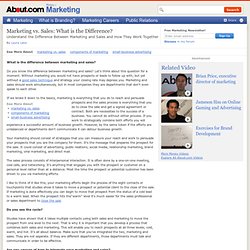
Do you know the difference between marketing and sales? Let's think about this question for a moment. Without marketing you would not have prospects or leads to follow up with, but yet without a good sales technique and strategy your closing rate may depress you. Marketing and sales should work simultaneously, but in most companies they are departments that don't even speak to each other. If we broke it down to the basics, marketing is everything that you do to reach and persuade prospects and the sales process is everything that you do to close the sale and get a signed agreement or contract. Costa Coffee attracts nearly 4m customers a week. Costa Coffee sales rose by 7.1% in the last three months against the backdrop of protests and boycotts against its closest rival Starbucks because of the US chain's controversial tax arrangements.

"We have been the UK's favourite coffee shop for some time; we remain the taxman's favourite coffee shop too," declared Andy Harrison, chief executive of parent company Whitbread. Harrison said it was impossible to attribute Costa's increasingly strong performance to the controversy surrounding Starbucks's tax affairs, but he noted that Costa had enjoyed a record week last week, with UK stores – excluding franchised shops – taking £10m and attracting 3.8m customers. The weather may have played a part too – cold but dry, a perfect blend for coffee shop sales. Harrison said he had seen the results of a YouGov brand preference survey, conducted at the end of October, shortly after a Reuters report highlighted Starbucks' low UK tax payments.
Coffee Supply And Demand. Food.pdf. Coffee Beans: A Market To Watch In 2014. Coffee is a commodities market to watch late this year and into 2014, as historically low coffee bean prices should reach a bottom and revive investor interest, according to one commodities expert.
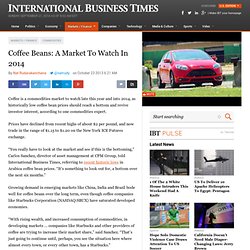
Prices have declined from recent highs of about $2 per pound, and now trade in the range of $1.15 to $1.20 on the New York ICE Futures exchange. “You really have to look at the market and see if this is the bottoming,” Carlos Sanchez, director of asset management at CPM Group, told International Business Times, referring to recent historic lows in Arabica coffee bean prices. “It’s something to look out for, a bottom over the next six months.” Growing demand in emerging markets like China, India and Brazil bode well for coffee beans over the long term, even though coffee companies like Starbucks Corporation (NASDAQ:SBUX) have saturated developed economies. Gulp! New coffee prices due to big dry will be hard to swallow. Percolating: Prepare to pay more for a cup of coffee as supply costs rise.

Photo: Craig Abraham The price of a morning caffeine hit is set to become more costly, rising 10¢ to 60¢ a cup, as a drought on the other side of the world threatens global coffee supplies. Arabica coffee bean prices have surged 76 per cent since the start of this year, and Australian roasters are now questioning how much of the increase they can absorb. The market hit a two-year high last week, above $US2 ($2.20) a pound. Unseasonably dry weather during January and February in Brazil, the world's biggest coffee producer, triggered the rally.
1972-2014. Coffee Historical Prices Charts - Historical Commodity Futures Charts' : ICE Futures. March Coffee Historical Prices Charts - Historical Commodity Futures Charts' : ICE Futures. Top 10 facts about coffee. For full details aboout coffee week and to hear the official coffee anthem, see www.ukcoffeeweek.com 1.

The Dutch drink more coffee than any other nation, an average of 2.414 cups each, every day. 2. Coffee is said to have been discovered by a ninth-century Ethiopian farmer, who realised his goats were going crazy over coffee beans. 3. 4. 5. 6. 7. Supply Definition. Nestlé case studies, videos, social media and information. Nestlé case studies, videos, social media and information. The supply chainis the sequence of activities and processes required to bring a product from its raw state to the finished goods sold to the consumer.

For coffee, the chain is often complex, and varies in different countries but typically includes: growers - usually working on a very small plot of land of just one or two hectares. Nestlé case studies, videos, social media and information. Progress Farming - The Nescafé Plan - NESCAFÉ COM. The NESCAFÉ Plan for responsible agriculture.

Our aim is that we meet the needs of the present without compromising the ability of future generations to meet their own needs. Thailand - The Nescafé Plan - NESCAFÉ COM. How could Nestlé ensure its coffee supply from the 25,000 growers who tend around 60,000 hectares of robusta coffee beans?
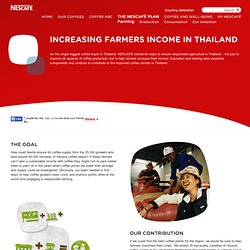
If these farmers can’t earn a sustainable income with coffee they might turn to para rubber trees or palm oil in the years when coffee prices are lower than average and supply could be endangered. Obviously, our team needed to find ways to help coffee growers lower costs and improve profits while at the same time engaging in responsible farming. NESCAFÉ will continue to help Thai farmers improve coffee sustainability via education and training. Save Water - The Nescafé Plan - NESCAFÉ COM. The village of Hama, 500 kilometres south of Ethiopia’s capital Addis Ababa, is known for producing Yirgacheffe Arabica, recognised as one of the best coffee beans in existence.
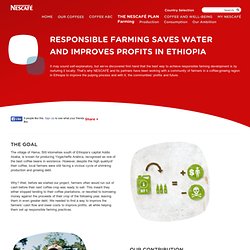
However, despite the high qualityof their coffee, local farmers were still facing a vicious cycle of shrinking production and growing debt. Why? Well, before we started our project, farmers often would run out of cash before their next coffee crop was ready to sell. This meant they either stopped tending to their coffee plantations, or resorted to borrowing money against the proceeds of their crop of the following year, leaving them in even greater debt. We needed to find a way to improve the farmers’ cash flow and lower costs to improve profits, all while helping them set up responsible farming practices. Guatemala Farming - The Nescafé Plan - NESCAFÉ COM. In the food industry, we rely on long-term supply of quality agricultural raw materials.
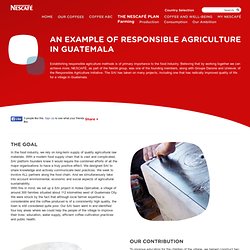
With a modern food supply chain that is vast and complicated, SAI platform founders knew it would require the combined efforts of all the major organisations to have a truly positive effect. We designed SAI to share knowledge and actively communicate best practices. We seek to involve ALL partners along the food chain. Save Water - The Nescafé Plan - NESCAFÉ COM. Common code - The Nescafé Plan - NESCAFÉ COM. 4C is voluntary, open, inclusive and participatory. We offer guidance for sustainable agriculture practices in the production, processing and trading of green coffee, the raw material used by roasters to produce the final beverage. 4C includes a support network where coffee companies and research organisations cooperate to help farmers. Those who buy 4C coffee are committed to buying increasing amounts of coffee over time while contributing to these support mechanisms for coffee producers.
The 4C Association shares responsibilities along the whole supply chain. Because the Code criteria have been developed as a traffic light system of red, yellow and green, coffee farmers can easily identify areas where they are already on track, and other areas which require more work. They self-monitor their progress and can see for themselves how they are improving.